Economic Impact of the 2017 Highly Pathogenic Avian Influenza Outbreak in South Africa
The recent outbreak of highly pathogenic avian influenza (HPAI) in South Africa had a notable effect on the poultry industry – one of South Africa’s largest agricultural subsectors. To facilitate rigorous response strategies to these outbreaks, quantification of the disease’s impact is critical. South Africa’s strategy, to date, was to contain the disease through culling at affected sites. While a possible vaccination strategy is being considered, such a strategy has not been formalised. In the international context, a culling strategy has typically been accompanied by compensation to affected producers, which further highlights the importance of quantifying the economic impact of the disease. This report therefore evaluates the economic impact of the 2017 HPAI outbreak in terms of a retrospective, as well as forward looking analysis.
The retrospective analysis considered biological loss, income foregone and direct costs associated with the outbreak. Total cull numbers from the reported AI outbreaks in the broiler and layer industries are estimated at around 5.4 million birds. The effect on the layer industry has however been much larger than in the broiler industry with around 4.7 million birds culled in the laying sector as opposed to around 700 000 birds in the broiler sector, which was predominantly affected at breeder level. The total biological loss associated with these numbers amounts to just over R 317 million rand. Of this approximately 75% accrues to the commercial laying industry and its various stages of production. Direct costs associated with the outbreak was around R40.5 million, which could be even larger given the poor response rate on issues related to direct costs associated with the outbreak. In terms of income foregone the total value is estimated at just over R1.5 billion rand, which includes income lost from egg sales, pullet sales, day old chick sales and broiler meat sales. Of the total loss, 85% accrues to the laying industry. It should be noted that the income foregone is not an instantaneous loss and the impact would be spread over a period of more than 2 years. It also did not account for company specific management strategies to mitigate the impact, such as utilisation of excess capacity to reduce the impact on day old chick volumes. This was specifically the case in the broiler industry. Given what is presented in the report, the total loss could amount to around R1.87 billion if biological losses, direct costs and possible income foregone is considered. This represents 18% of the total gross value of egg production in 2016 and 1.6% of the total gross value of animal products in 2016.
The forward-looking analysis was aimed at quantifying the price impact associated with the loss of production, as well as differences in restocking strategies. It is mainly focused on the commercial laying industry due to the substantial effect the disease had on this part of the sector. Using a quarterly partial equilibrium model of the South African layer industry, it evaluated 2 different scenarios. The first is a scenario where restocking rates are driven by (current) high priced incentives associated with eggs. In the second, a vaccination strategy that allows incremental restocking within the confines of the production cycle is considered. The first scenario resulted in an egg-price shock of 22% relative to a baseline simulation, peaking in the first quarter of 2018. The second scenario showed a similar increase of 22% relative to the baseline, but peaking in the fourth quarter of 2017. Simulation results however suggest that a vaccination strategy will support growth in production to mitigate the initial impact with around 12%. Ultimately, this strategy, combined with current price incentives, also supports longer term production growth, with prices reaching an equilibrium below price levels considered as a baseline in the simulation. From a consumer perspective, the price impact of the outbreaks on egg prices is expected to amount to an increase of around R4 per dozen which has already been evident in the last quarter of 2017 and the first quarter of 2018.
Although interviewed respondents explicitly indicated their support for a comprehensive vaccination strategy, this course of action would have substantial implications. The first relates to trade. The analysis presented here suggest that vaccinations will have an impact on possible broiler exports. The threat of imports from countries that are already classified as endemic with HPAI seems unlikely since the current export mix from these countries (specifically China) does not match the current South African import mix. The second implication relates to how spent hens are disposed of. Under current circumstances, hens are sold to hawkers to be traded in the informal market. Under a comprehensive vaccination strategy, this option is no longer viable. In order to fully gauge the impact of this would require further in-depth research. The use of a compartmentalised vaccination strategy would mitigate the impact on the live bird market and also protect South Africa from an endemic status.
As with most agricultural sectors, it should be noted that the effect of a disease such as HPAI entailed severe losses in certain areas, while producers that were not affected in fact benefitted from higher prices. Therefore, one should not consider the aggregated national impact, without noting that affected areas suffered severe losses. Compensation of such losses is critical when a culling strategy is followed to contain the disease. Despite the decline in production volumes, the nature of the product implies that trade has a very limited role in the domestic market and therefore, the disease also resulted in substantial price increases, which does entice some producers to take the risk of expanding production, but also results in a much higher cost and reduced consumption levels.
Download the full report.
